The worst USN fighter ever ?
The Brewster Buffalo has quite a reputation in WW2. For many, it was “the worst fighter of WW2”. That can be analysed in facts and put in relation to the context of its deployment, and compared to the plane’s actual technical issues. But at the end of the day, it started as a naval fighter, ordered by the USN to a young and relatively untested company.
Long story short, the Navy tried it, and curtailed the order as soon as reports came in. The production models then were passed onto the “second market” of lend-lease, the British operated it, as did the Dutch in the same theatre of operations, and the Finns. In the hands of the latter it did apparently wonders, which makes the whole case of “worst of WW2” a statement to take with at least a pinch of salt. Now here you go, let’s dive into this model squarely and look at its short career in the US Navy where it started.
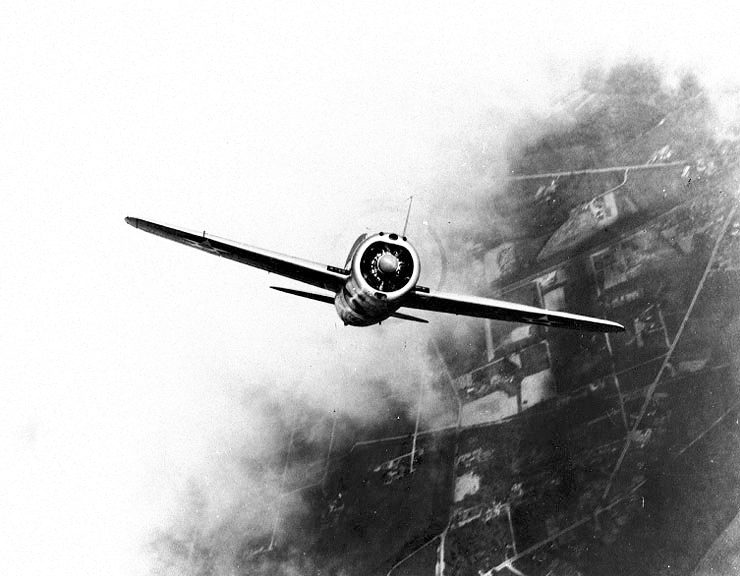
Brewster XF2A-1 in trials, 1938
Genesis of the Buffalo (1935-39)
All started in 1935, and the U.S. Navy requirement for a carrier-based fighter, scheduled to replace the Grumman F3F biplane. As usual several manufacturers were contacted, and answered the call in the time specified with a tender. There were two rounds of examination, and Brewster was one of the two companies that were picked up in the first round. They presented the
Brewster XF2A-1 monoplane. It was designed by a team led by Dayton T. Brown. Competing here was the Grumman XF4F-1, powerful with its double-row radial engine but still built as a biplane. The U.S. Navy wanted more proposals and especially to test more monoplane and reopened the competition, just to open the door to allow another competitor, Seversky aviation and its XFNF-1, a navalized P-35, already well liked by the US Air Force. It was tested but quickly eliminated in the straight line speed test, as not capable to reach the specified speed, as it could not do better than 267 mph (430 km/h) – still honorable in 1936.
Brewster’s XF2A-1 first flew on 2 December 1937 and further tests showed the commission it was more advanced in many ways than its Grumman competitor. Therefore, as the Navy had some preference for monoplanes, Brewster’s model was retained as a winner. Grumman would not scrap its XF4F-1 entirely and refined the design in turn as a monoplane. They would ultimately took their revenge over Brewster as the Wildcat became the staple of the carrier fighter force until 1943.
The Brewster’s saga: Mismanagement at its best.
The New-York based company called Brewster Aeronautical Corporation was at first a defence contractor, and a branch of Brewster & Co.a venerable and respected coach and carriages seller, car body and finally aircraft parts. This division was eventually purchased by James Work, an aeronautical engineer in 1932. In 1932-34 it started by making seaplane floats and wing panels, but after hiring engineer Dayton Brown, the team became bold enough to see the advantage of proposing the army full-blown planes rather than just manufacturing parts. At first, there was the historical plant, “Brewster Building” in Long Island City, New York and another at Newark in New Jersey. During the war, production stepped-up and from 1941, NAS Johnville in Warminster Township, Pennsylvania.
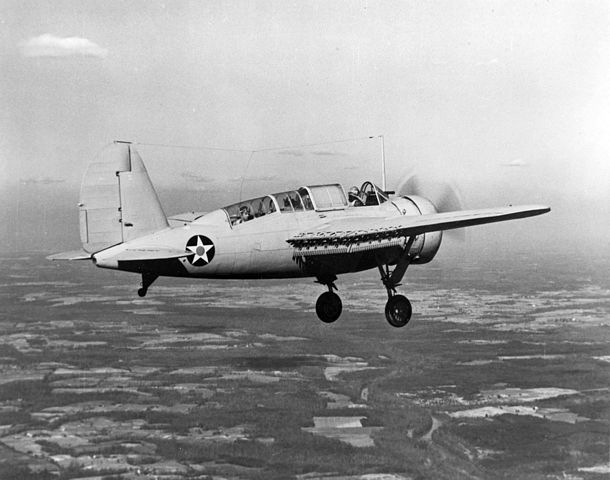
The Brewster SBA, here SBN-1 in flight in early 1941.
James Work, rather than directly attacking the Air Force were competition was fierce and large orders (so potential production issues) were the norm, opted for the more open Navy. For this in 1934 already, Dayton Brown designed a prototype to answer a competition for a modern two-seat scout-bomber. That type of plane was considered less risky at the time than a dive bomber or a fighter, especially for a very young company. The project Brewster SBA presented many characteristics the Navy liked. It was a modern monoplane with retractable wheel carriage, which looked rugged enough, had perforated braking flaps, and carry a crew of three with relatively good characteristics of speed and range, at least on paper. The Navy therefore ordered one prototype, designated XSBA-1, on 15 October 1934.
The company then manufactured it and refined details like an internal bomb bay capable of taking a 500-pound (227-kg) bomb and a flexible machine gun at the rear for the aft gunner. It was equipped with a Wright R-1820-4 Cyclone which gave 770-horsepower and made it capable of flying at 254 mph (409 kmh), which for this type, was quite acceptable in 1935. The 1000 miles range also was crucial to win the contract. The XSBA-1 first flew on 15 April 1936 at Brewster, before being handed over to the Navy. However as it was tested during 1936, some minor problems appeared and the Navy ordered a revised tail and rudder. Later it was also estimated the cell could accept and a more powerful Wright R-1820-22 Cyclone rated for 950-horsepower (710-kilowatt). New tests were performed and the prototype was found more responsive and moreover reaching now 263 mph (424 km/hr), which at the time believed to be a world record for a single-engine bomber. The Navy accepted it for production and ordered a first batch of 30. However by that time Brewster was unable to setup production in time, already found deeply embedded in the development of its more ambitious F2A prototype fighter.
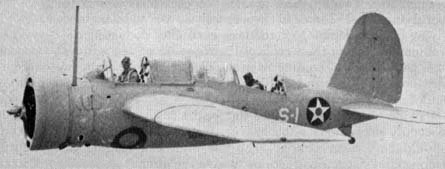
Brewster SBN-1 in flight. All 30 built had a short operational life and served mostly as trainers until August 1942 and scrapped.
As often in that case, the Navy simply acquired the license (in wartime it would have been just requisitioned and donated for free) and gave it to its own-grown Naval Aircraft Factory, in September 1938. However NAC at that time was itself pressured by other productions and delays accumulated. The first of the SBN-1s left the factory floor only by November 1940 and the production dragged on until… March 1942, which by that time, the high top speed of the 1936 prototype was no longer and advantage. The SBA was considered obsolete already in 1941. The first to operate the bomber was Bombing Squadron 3 (VB-3) aboard USS Saratoga (CV-3). Other served with Torpedo Squadron Eight (VT-8) in 1941, but all ended as trainers onboard USS Hornet. In the end, none saw active combat during WW2. Pilots have no particular praises for it and it was just found much better without payload. This could have warned the Navy, but by then the F2A production was already in full swing. Indeed, for this more ambitious order, the company lacked time initially to answer with a brand new model and took the SBA as a base for development, simply shortening it. Perhaps many of future issues started there. Nevertheless, as delays hampered the SBA production, the company won another order, this time for the Brewster SB2A Buccaneer (RNAF: Brewster Bermuda).
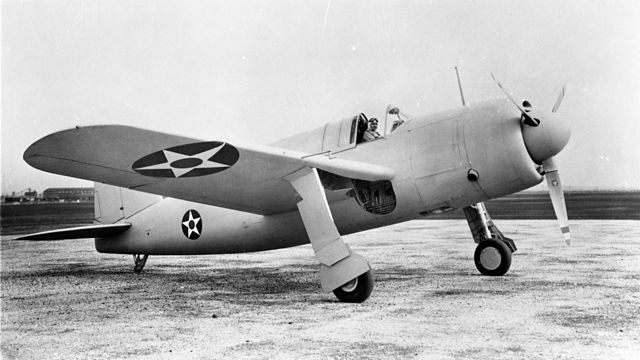
Brewster XSB2A-1. Essentially a larger, more rugged, carrier-borne torpedo-scout heavily based on the SBA, which first flew in june 1941. The Navy like its powerful single Wright R-2600 engine. In June 1940 already the French ordered it on paper (as the Dutch), and after the fall of France, they were taken on by the British. In all, 773 were manufactured, the last in 1944. However, with the modifications asked by the Navy, the 1941 SB2A became slow and overloaded and it was discovered its airframe was fragile. The folding wings were introduced on the SB2A-3, 60 of them which were among the last ordered by the Navy, added to 80 SB2A-2s in 1943. The bulk went to the British RNAF (and ended scrapped almost at arrival). In the end, the USN found the SB2A unsuitable for combat and even training, they were all relegated as target tugs and to train ground maintenance teams. In 1945 the Truman Committee stated that the SB2A “turned in a miserable performance”.
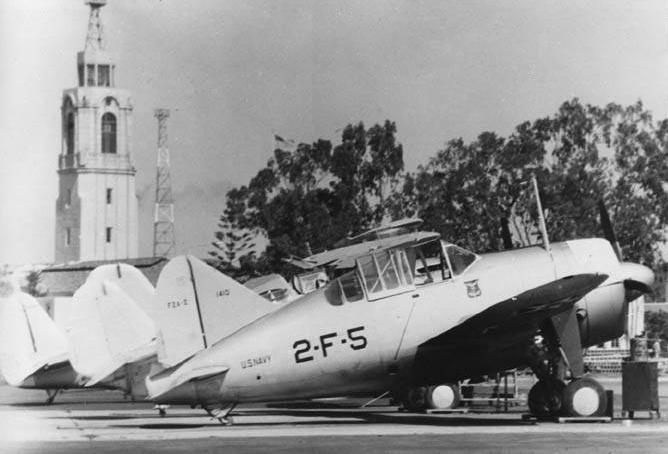
Brewster F2A of VF-2 Parked in Pearl Harbor, 1941
In 1941, especially after the debacle of the Buffalo, Brewster lost all credibility. It started to appear to the Navy procurement board that Brewster as a company was seriously mismanaged. Its growth had something almost unnatural, from a minor aircraft parts supplier to full-fledged army manufacturer, ranked 84th among US corporations in value for military production contracts. Attention squarely fell on Jimmy Work in particular, which hired Alfred and Ignacio Miranda as his main salesmen. It appeared after enquiry that the men had been involved in many frauds, and spent two years in prison for illicit arms sales to Bolivia. As later established by an investigation, during all the time the company promoted its model, both had systematically over-promised, creating outright formidable capabilities to customers. And as it was not enough, it was compounded by numerous delays and the overall disappointing quality of the products, mainly due to a too quickly hired workforce and staff management failure.
It happened neither the skills or motivation of this hired personal were checked. As a result, illicit strikes became mandatory and seriously delayed production, going down as far as outright sabotage. The Navy became so concerned by these delays, that they basically fired Jimmy Work and installed George Chapline as president. The latter apparently managed to fix personal issues, step-up production speed and quality. In early 1942, Jimmy Work retook its post, but he was sued for $10 million for financial misdeeds. On April 18, 1942 the Navy seized the company outright and placed it under direct management of Naval Aircraft Factory’s boss, George Conrad Westervelt. By mid-May 1942, the direction was enlarged with a new board of directors, also appointed by the Navy, and Brewster was tasked to produce the proven F3A-1 Corsair, under license. However, even this proved fruitless, and the whole contract was cancelled by the Navy on July 1, 1944, after 735 Brewster F3A Corsair left the factory.
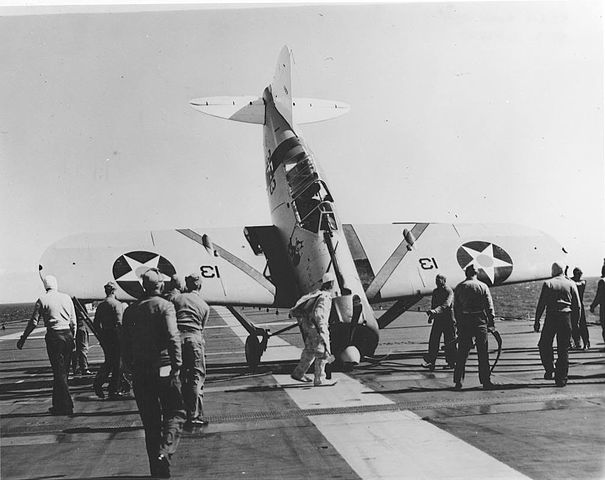
F2A Thach accident onboard USS Saratoga, 1940
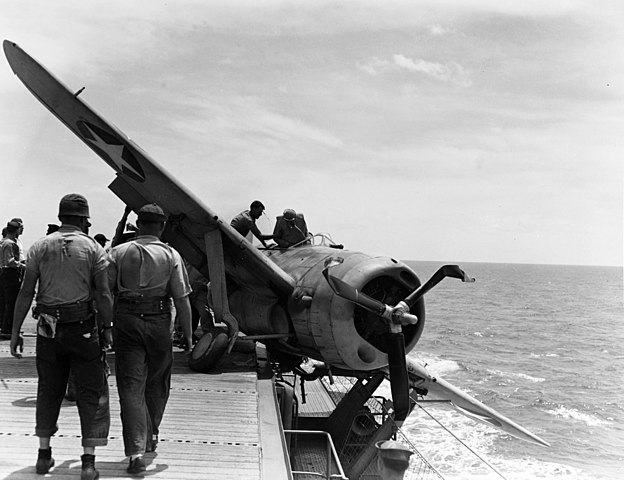
Accident with a F2A-3 of VMF-211 onboard USS Long Island, 25 July 1942. The A-3, even more than the A-2, was plagued by wheeltrain failure.
In between, by May 1943, the company competed for a ground attack navy plane with the Brewster XA-32, but its performances were judged “abysmal” and it never get any approval. In October 1944, Brewster was practically bankrupt, human resources were re-affected elsewhere and assets gradually sold. By 1946 it was dissolved as an entity. The performances of this army contractor were such that in 1943 already, the Congress committee of naval affairs created a sub-committee to investigate the massive “failure of production” of the company, making hearing and reviewing documents for three months, between October and December 1943. The document can be found here or type “Investigation of the Progress of the War Effort: Brewster investigation
By United States Congress House Committee on Naval Affairs” on Google Books.
Development of the F2A
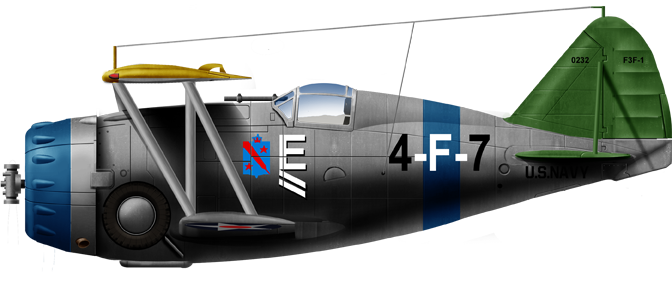
The Grumman F3F, the F2A was replacing
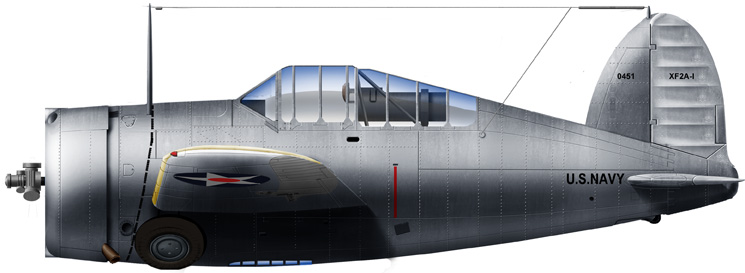
Brewster XF2A-1 in 1938 (Author’s dedicated illustration, like the others)
At first glance, the idea of taking this SBA bomber and removing entire sections to shrunk it to its elemental core sounded likely to take the best of a similar engine and increase performances radically. So it was thought by the team… and the Navy, which found itself subjugated by the idea of having its first modern monoplane, and a model well in advance compared to rival USAF’s own monoplane fighters of the time like the P26 “Peashooter”… as it was sold. It all started well for Brewster, and the company worked hard to deliver a potent mix for a Navy fighter, in time.
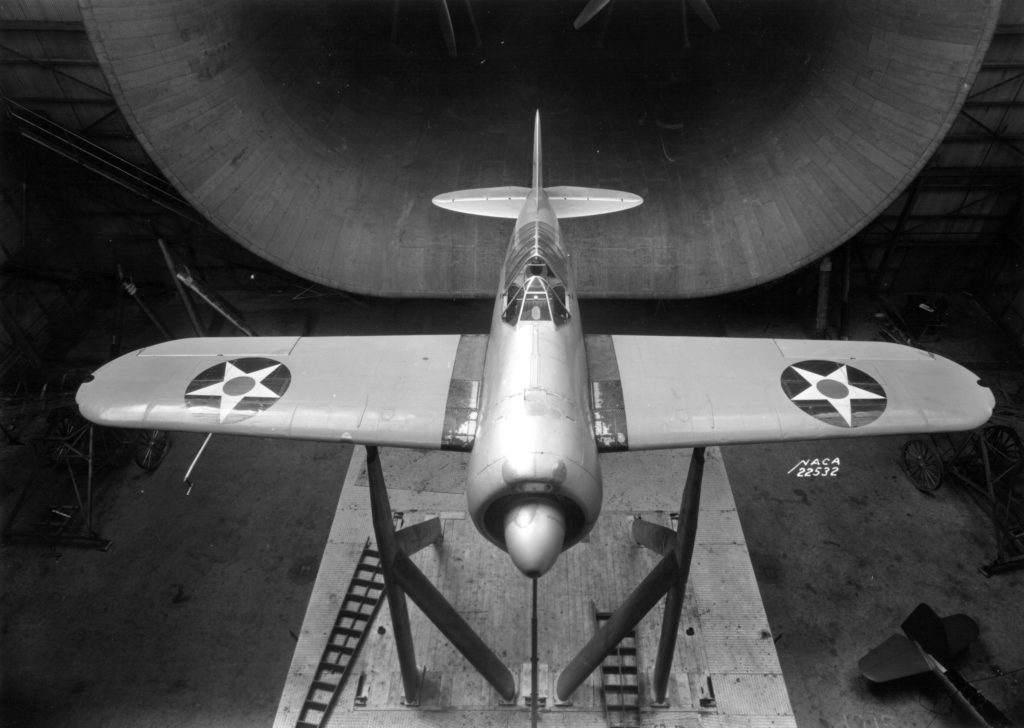
The famous XF2A-1 NACA wing tunnels trials, which launched a standard in US aviation (cc – NASA archives)
The new Brewster fighter had almost a barrel-like first look, with a stubby fuselage and mid-set monoplane wings. It also promised (and delivered at least some) advanced features for the time. It was all-metal, built of flush-riveted stressed aluminium skin. To save weight and cost however, control surfaces were still fabric-covered. The XF2A-1 had also split flaps and an hydraulically operated retractable main undercarriage, as well as -quite a luxury for the time- a partially retractable tailwheel. It also had a large, roomy and luminous streamlined framed canopy ensuring excellent visibility all around. Of course for this generation, it still lacked self-sealing fuel tanks and the pilot’s neck was not protected by an armor plate. Despite its stubby look, the Brewster fighter only carried 160 U.S. gal (606 l), entirely stored in the fuselage. Of course its beating hart was a generous 950 hp (708 kW) single-row, Wright R-1820-22 Cyclone radial engine. This was one of the most powerful engine in the US at that time, allowing an impressive initial climb rate of 2,750 ft/min (on paper) and promised a top speed in excess of 277.5 mph (447 km/h). These figures, and the whole package seemed more promising by anything the competition put forward at the time, to the dismay of the latter which saw Brewster as a meteoritic newcomer from nowhere.
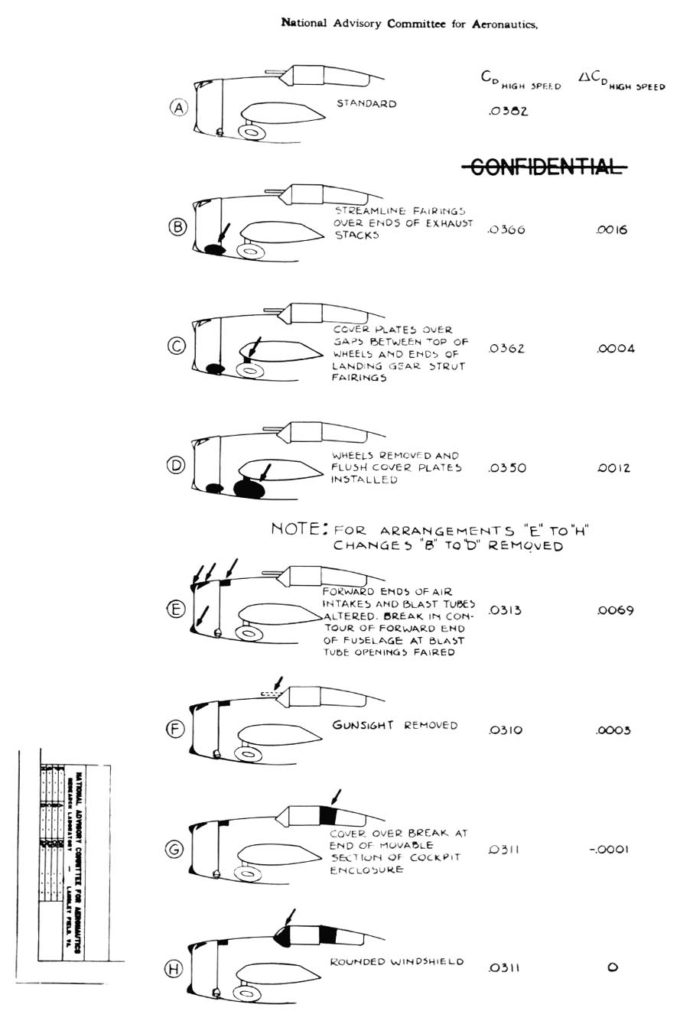
NACA recommendations to improve the Brewster XF2A-1, LMAL chart of the test arrangements. The two columns of numbers show quantitatively the effects of the configuration variations (src NASA).
Tests of 1938
The prototype was then tested in 1938 at the Langley Research Center, in a full-scale wind tunnel. There, the engineers determined the model had parasitic drag to be fixed. The company made improvements, notably on the cowling, by streamlining it and the carburetor and oil cooler intakes. When flying after these modification, the prototype rose to 304 mph (489 km/h) at 16,000 ft (4,879 m)with the same engine, proving these tests indispensable. The Navy was delighted as its fight was now the fastest in the US. Other manufacturers took notice of this 10% increase and wind tunnel tests became not only popular, but soon imposed as a standard procedure. However it was also noted during these tests, that the fighter’s single-stage supercharger was not able to feed the engine at high-altitude, and performance fell rapidly. At some point, as requested by specifications, it was time to fit and test an armament. To start with, a singl fixed .50 in (12.7 mm) M2 Browning machine gun was fitted in the nose, supplied by 200 rounds. Also was fixed a single .30 in (7.62 mm) AN Browning machine (600 rounds) in the same location. Impressed by this, the Navy awarded Brewster the production contract it was battling for, ordering a first batch of 54 aircraft, called F2A-1, mainly for unit evaluation and service.
Delivery of the F2A-1 (1939)
Meanwhile, testing of the XF2A-1 prototype went on throughout in January to June 1938, while production was setup. The definitive production engine was the more modern Wright R-1820-34, which had better cyclic performances while delivring a slightly lesser output of 940 hp (701 kW). The prototype also tested a larger fin, following recommendation. The Navy for the production model asked for two additional .50 in (12.7 mm) Browning wing guns, and to fit all the equipment required by the Navy for combat operations. Soon problems commenced for the first F2A1 when received by their pilots: The weight addition reduced the rate of climb to only 2,600 ft/min, versus 2,750 ft/min initially. But the main problem became the plane delivery, which soon went off-schedule: Indeed by then the company was plagued by production difficulties and only 11 F2A-1 were delivered that year. Soon, the remainder of the batch of 54 (so 43) were diverted to lend-lease, and purchased by the the Finnish Air Force. It had the export designation Model 239.
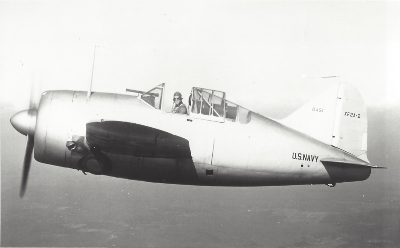
Buffalo prototype XF2A-2
The F2A-2 (1940)
The F2A-2 was designed by following a new set of navy requirements. 43 were ordered this time. The main requirement was indeed a more powerful engine: The Wright R-1820-40. The Navy also contacted NACA which in turne proposed a better propeller design. The Navy also wanted an integral flotation gear, but at that stage, still no pilot armor or self-sealing tanks. The power increased was immediately well received by test pilots, but meanwhile, the loaded weight increased dramatically, to 5,942 lb/2,701 kg. Top speed, still, had increased to 323 mph (520 km/h) at 16,500 ft (5,029 m) altitude, but the initial climb rate went down to 2,500 ft/min.
At first the pilots liked the F2A-2. Amazingly enough, “Pappy” Boyington himself praised its good turning rate and agility, but also remarked without a doubt that the much lighter early models, “were pretty sweet little ships. They could turn and roll in a phone booth.” as written in his autobiography “Baa Baa black sheep”. Wing loading at the time indeed was the same as the legendary Mitsubishi A6M Zero, 22 pounds per square foot. However, the Navy required soon other modifications. All F2A-2s were integrated in active Navy units. For a time. But these initial models were those shipped to Finland in 1939, which explains what happened later.
The F2A-3 (1941)
The F2A-3 was the last ordered by the Navy and Marines Corps, up to 108, in January 1941. However the staff noted the abnormally slipping delays at the Brewster Aeronautical Corporation and management difficulties and the order was just a way to ensure their production lines were busy to deliver what was promised initially. The modifications asked for this model were quite extensive: The Navy wanted a long range reconnaissance fighter, and was equipped with wet wing tanks, all self-sealing, as the fuselage tanks. The fuselage tank was also enlarged, ubut as a consequence, this added on the balance a whooping 500 lb (227 kg) while carrying an additional 80 U.S. gal (300 L). But it was not over, and to put the fighter to standards, an armor plating for the pilot’s head was asked for, and also increased ammunition capacity.
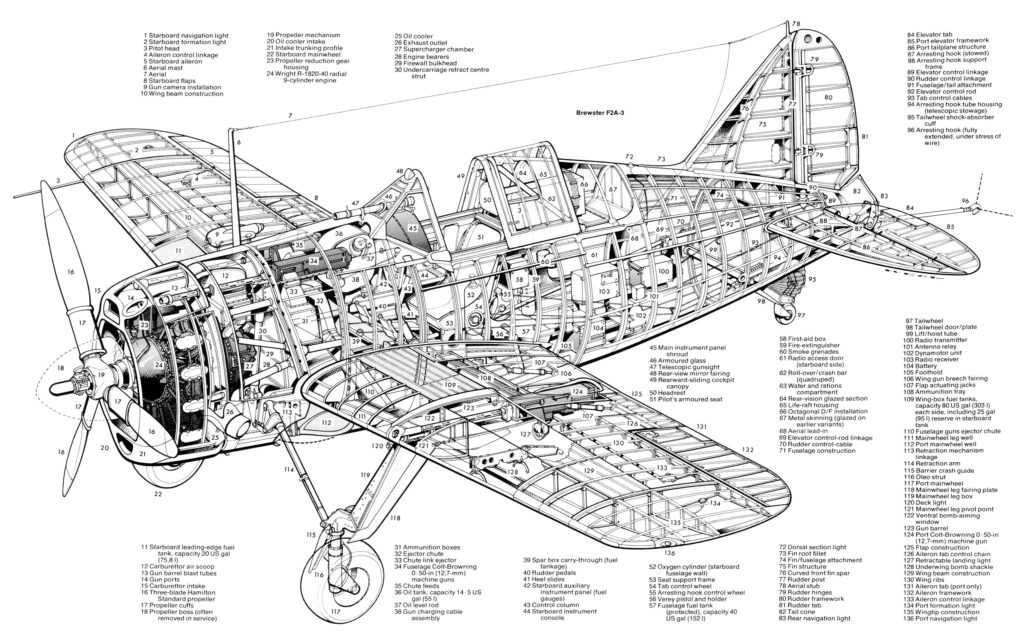
Brewster F2A-3 cutaway drawing. Src: http://nine.netbs.site
In the end, the A-3 became utterly sluggish. Its top speed and rate of climb fell considerably, as well as its turning and manoeuvring capabilities, since the wing loaded had been considerably increased. Navy pilots immediately brought this to attention, as well as an increasing rate of accident, as the landing gear was apparently never designed to support the extra load and failed quite often during carrier landings. The same supercharged Wright R-1820-40 Cyclone was good for “cruising” but the added weight considerable hampered its capabilities. The Buffalo served briefly on the carriers USS Saratoga and Lexington. But deliveries were so slow that in the fall of 1940, it seemed obvious to the USN this model was obsolete, badly needed a more powerful engine, but limits of the airframe had been reached. No improvements could be made but only to strip the plane bare. As deliveries of the F2A-3 started, the Navy decided to withdrew it, as previous models. Relegated in the second line, it was transferred to the U.S. Marine Corps. The latter deployed two squadrons to the Pacific, Palmyra Atoll, and, famously, at Midway Island. At the time a reinforcement mission was ordered to Wake Island, the carriers were equipped with the F2A1, but this relief force was withdrawn as the island was taken in between. F2A-3 joined training squadrons as advanced trainers, the next step after training biplanes. Brewster actually studied a XF2A-4, converted from an F2A-3, with some improvements, but in never reached production.
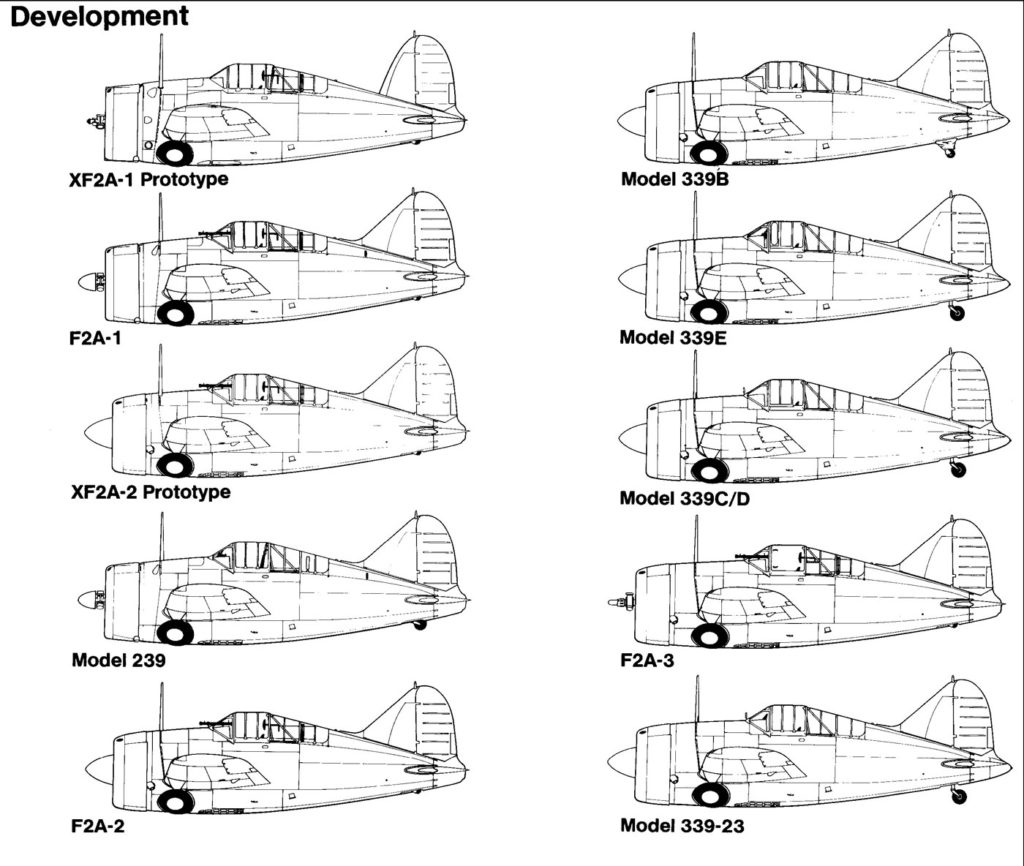
F2A family models and development history – src asisbiz
Export/Lend-Lease variants
B-239: F2A-1 exported to Finland (Wright R-1820-G5, four MGs, 44 in all, called “Brewster” or “Taivaan helmi”.
B-339B: Version for Belgium, same base, 40 built (2 delivered to Belgium, remainder to RN FAA)
B-339C: Version for the KNIL (Dutch East Indies), 24 built.
B-339D: KNIL too, but with the A-2 upgraded 1,200 hp Wright R-1820-40 Cyclone, 48 delivered.
B-339E: Export variant of the F2A-2 for the RAF with (GR-1820-G-105 Cyclone), 170 delivered
Buffalo Mk.I British name, later passed onto the RAAF/RNZAF.
B-339-23 (B-439): Export variant F2A-3 KNIL, Wright GR-1820-G205A engine: 20 built (17 RAAF).
The Buffalo Mark I was modified on demand by the British, and became “a dog”, explaining in part its poor record. Indeed initially, the B-339E (Brewster Buffalo Mk I) had an export-approved Wright R-1820-G-105 Cyclone engine rated for 1,000 hp (745.7 kW). But they were soon equipped with a British Mk III reflector gun sight, gun camera, a larger fixed pneumatic tire tail wheel, a fire extinguisher, engine shutters, a larger battery, reinforced armor plating, armored glass. This of course caused the weight to soar up, taking some additional 900 lb/400 kg, while it was still less powerful than its USN equivalent. Top speed was down from 323 mph (520 km/h) to 313 mph (504 km/h), it climbed slowly, had difficulty to reach altitude. The planned 21,000 ft (6,400 m) were never approached due to fuel starvation, and a poorly designed supercharger, and was heavier to handle. Also as the original engine was lacking, some were equipped second-hand, worn-out Wright engines from Douglas DC-3 airliners or refurbished G105 or G102A models. Some were lightened in an attempt to regain some performances, by saving 1,000 lb (450 kg), removing the armor plate, armored windshields, radios, gun camera, and equipment fitted before, as well as the .50 in (12.7 mm) by lighter .303 in (7.7 mm) MGs, and they carried less fuel. So this Buffalo I was even better equipped than Navy planes, without the tail-hook and other specifics, but had really downgraded performances, and this is crucial to understand how they performed.
Src, read more
https://scale-model-aircraft.com/plans-drawings/interwar-aviation/brewster-f2a-buffalo
The models corner:
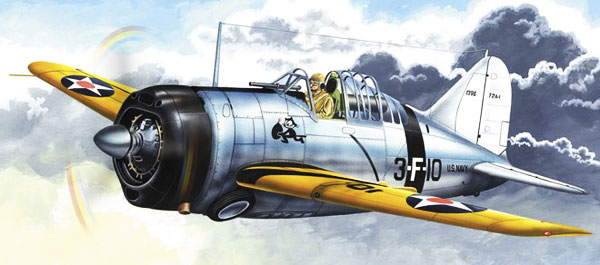
Existing kits of the Buffalo (scalemates database)
Ideas and users of the Buffalo (wingspalette)
The Buffalo in action with the USN & USMC
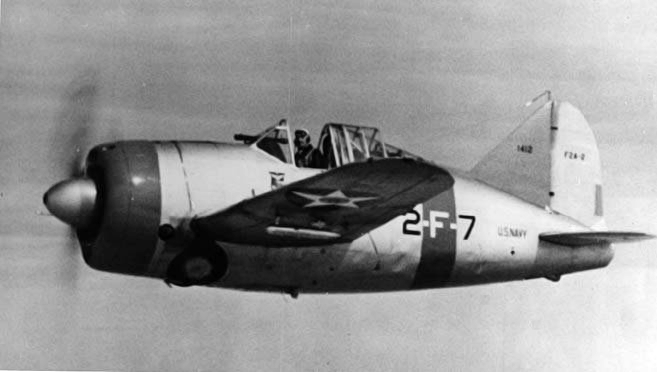
F2A-2 of the VF-2 in flight.
The Brewster F2A in the US Navy
As we saw, the F2A-1 and A-2 saw service in 1939-40 with the USN on carriers and land-based units. On the A-3 the landing gear issues and mediocre performances meant they only saw limited service. These were the VF-2 (USS Lexington, disbanded 1st July 1942), VF-9, VJ-5, and later versed to the VJ-6, VS-201, and eventually the training Units at NAS Pensacola and NAS Miami. When the fleet was mobilized to bring relief to the besieged Wake island, some were stacked onboard USS Lexington and Saratoga. But this it never happened as the relief was controversially cancelled, and after their return, Buffalos were disembarked and replaced straight away by the Grumman F4F.
VF-9 was actually created at NAS Norfolk on 1st March 1942 to train pilots for the future USS Essex in construction. The unit was first equipped by F2A-3 Buffalo, replaced in April. VJ-5 and VJ-6 were “utility squadron” which used it primarily for training. Up to that point, the Buffalos were relegated to secondary roles, advanced training, static mechanical training, target towing. VS-201 was Scouting Squadron 201 (VS-201), a training unit, operating from the carrier USS Long Island. In 1943 they started to be replaced by F4Fs and the F2A were scrapped. This was the last time Buffalos were ever seen on a USN carrier. At no point, the F2A saw combat active combat with the US Navy, but some did, with the USMC.
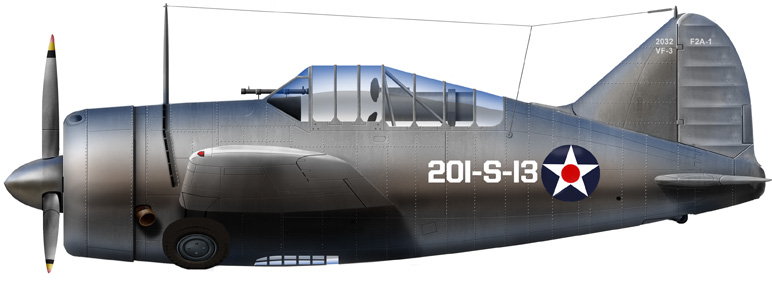
Brewster F2A-1 of the relief unit bound to Wake before cancellation, VF-3, USS Saratoga
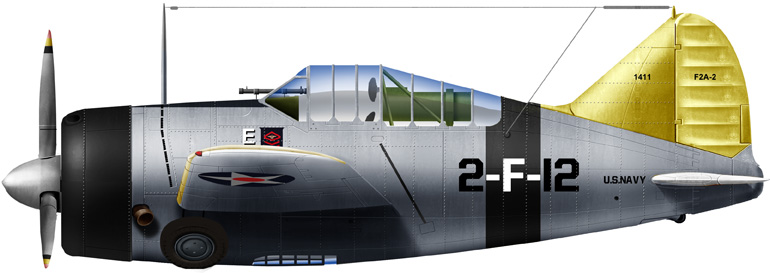
Brewster F2A-2 USS Lexington, Spring 1941
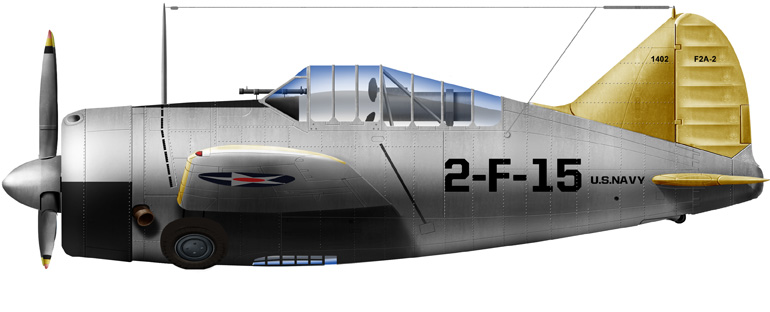
Brewster F2A-2, VF-2 USS Saratoga, 1941
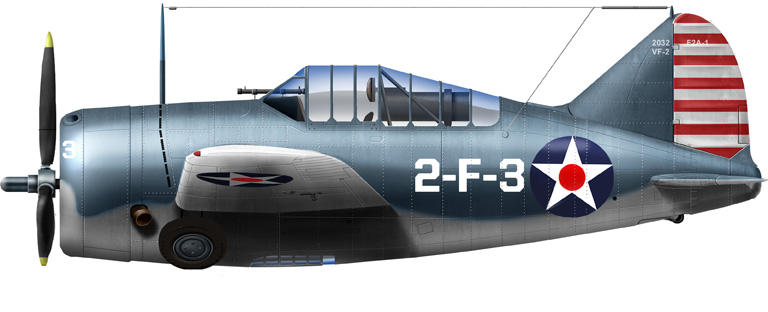
Brewster F2A-1, VF-2, early 1942
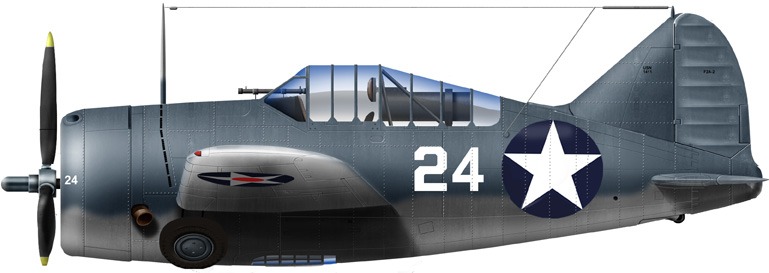
Brewster F2A-2, NAS Miami Flight School, July 1942
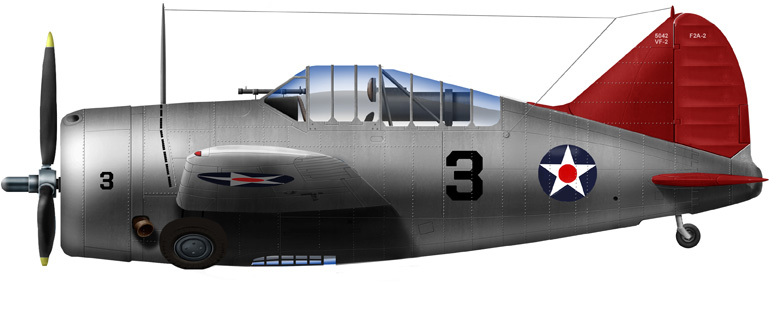
Another F2A-2 of NAS Miami, 1942
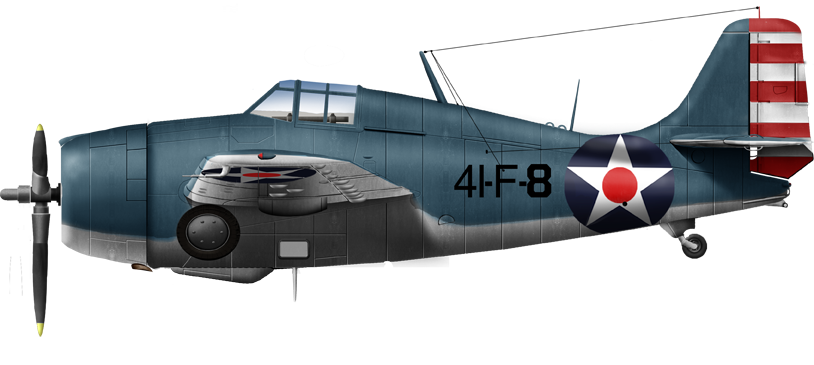
Grumman F4F, the fighter which replaced the Brewster, with great relief to the Navy in 1942.
The Brewster F2A with the USMC
The Buffalo, A-2 and A-3 in particular, were used by the USMC, notably VMF-111 based at Camp Kearney, California. The reserve fighter squadrons operated from 1938 Boeing F4B-4s and after Grumman F3F-2s, and it seems the F2A only was used as a stopgap before the F4F could be obtained in 1941, but in December, they had F4Fs.
The model was also used by the VMD-2 (no source), VMF-211 (Palmyra Atoll, possibly summer 1941), VMF-212, 214, 222 based at MCAS Ewa (also possibly in 1941, in between the F3F and F4F). However the most famous user of the Buffalo was without doubt VMF-221, which was deployed at Midway. Other units allegedly using the Buffalo were VMF-224 and VMO-251. The former started operation near Hawaii on May 1, 1942 at Naval Air Station Barbers Point, apparently with F4F fro the start, while the latter was established in December 1, 1941 at Naval Air Station North Island, California. It probably flew at that time the Buffalo before transitioning in 1942 to he F4F.
The Buffalo at Midway (June 1942)
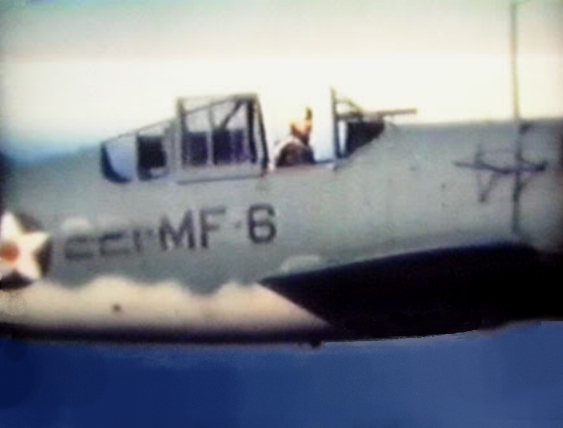
Brewster F2A-3 of VMF-221 in flight, 1941
VMF-221 was formed on July 11, 1941 in San Diego (California) and by December it was re-affected to the Marine Corps Air Station Ewa (Hawaii). On December 25, fourteen Brewster F2A-3’s took off from USS Saratoga and landed on Midway Island. This was the original Wake island relief force, after it was controversially recalled on 22 December. On March 1, 1942, VMF-221 teamed up with VMF-222 and VMSB-241 on the island, under command of Marine Aircraft Group 22 (Lt. Col. Ira L. Kimes). On March 10, 1942, a squadron took off for a patrol, and four F2A-3’s downed a Kawanishi H8K “Emily” flying boat. By late May, VMF-221 received a complement of Buffalos for a total of 21 F2A-3′, plus 7 Grumman F4F-3 Wildcats. These were however second-hand, worn out planes from the Navy. Squadron commander became Floyd B. Parks, and Kimes took command of Marine Air Group 22. These pilots, for the majority, were “green” recruits, straight from flight training Stateside.
On June 4, 1942, the Battle of Midway started, and pilots of VMF-221 scrambled to intercept a wave of Japanese bombers from four carriers, escorted by 36 Zero fighters. Parks led his squadron against and soon spotted a formation of Nakajima B5N “Kates”, followed by a formation of Aichi D3A “Vals” at higher altitude with the Zeros “stepped-up” behind them. VMF-221 started to target the bombers ad performed a few passes, but the Zeros quickly came into range, and the situation became hellish. At the end of the melee, fourteen USMC fighters had been shot down, including Parks. Jut two VMF-221 now were serviceable, out the 13 remaining after the Japanese bombed the airstrip. The squadron received a Presidential Unit Citation nevertheless, as being outnumbered five to one. Surviving pilots would fight in subsequent battles, like 2nd Lt Charles M. Kunz, still flying his Brewster F2A in Capt Kirk Armistead’s division, and later VMF-224, an ace with 8 confirmed aerial victories. Also Capt Marion E. Carl (F4F Wildcat) flew with VMF-223 and scored 18.5 kills.
Surviving Marine pilots who managed to shake off Zeros used high speed split-s turns and very steep dives, these manoeuvers became standard tactics. Te Buffalo was indeed rugged enough for these, even dive bombing (see the KNIL). Marine pilot Captain William Humberd succeded in diving and then attacking a Zero in a head-on pass, shooting it down. However pilots also complained of nose-mounted guns failure to fire probably caused by frayed electrical wires in the synchronized propeller mechanism. The absence plate armor caused other losses but the Japanese also commonly strafed bailed out pilots. Claire Chennault’s report on the Zero and tactics were heard in Washington and triggered the development of two-plane mutual defensive formations and tactics, applied by notably Lt. Cdr “Jimmy” Thach. It benefited greatly to Wildcat pilots. For the USMC, Midway marked the end of the operational use of the Buffalo. Surviving ones were shipped back to the U.S. mainland, and ended as advanced trainers in various bases, like Miami.
The Brewster F2A with other US units
The Buffalo was also versed to the USAF’s 5th Air Force based in Australia (ex-Dutch unit). This unit renamed the Far East Air Force on 7 December 1941 was tasked to defend the Philippine Islands. Its fighter groups mostly operated the P-40 but it’s likely one operated ex-KNIL B-339-23 (B-439) used also by the RAAF, some used by the USAAF in Australia.
The Buffalo with other operators
This is more anecdotal as our main concern here is the USAF, but the longevity and widespread use of this fighter was truly remarkable, especially for one with such appealing reputation. The Buffalo fought in the Pacific, but also in Europe, basically from the snows of the Taiga to east Asia, and strangely enough, became the favorite fighter ace mount for the Finns, but there were reasons for this.
The Finnish “Brewster” (1939-45)
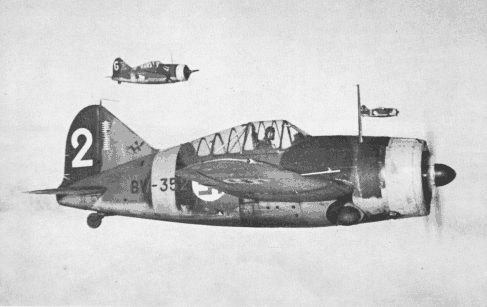
The important point is, there; to determine why the Finns were so successful with a plane that was essentially discarded by the USN and Royal Navy and performed poorly in the hands of the KNIL or the RAAF. First off, as early customers in April 1939, the Finns obtained the very first version F2A-1 (B-239E) requiring them to be already operational and use 87-octane fuel. 44 originally intended for the US Navy were diverted to Finland, and replaced by the F2A-2. On 16 December the purchase contract was ready for this F2A-1 variant, “de-navalized”, lacking self-sealing fuel tanks, cockpit armor but with a more powerful engine than the F2A-1, the 950 hp Wright R-1820-G5 and four machine guns. All and all, these B-239E had certainly the best power-to-weight ratio of any Buffalo in service and, adding other factors, explained its successes there. Th first crated planes transited through Bergen in January-February 1940 and sent by railway to Sweden, assembled by SAAB at Trollhättan (Gothenburg). Upon arrival, the Finnish Air Force added armored backrests and metric flight instruments. They also fitted the Väisälä T.h.m.40 gunsight and four .50 in local 12.7 mm machine guns. They had a top speed of 297 mph (478 km/h) at 15,675 ft (4,750 m) with a loaded weight of 5,820 lb (2,640 kg). One of these planes were matched against a Finnish Fiat G.50 Freccia, and showed although slower, it could out-turn it. Finnish pilots generally regarded the B-239E as being easy to fly, had good range and easy maintenance. The first kills came in 25 June 1941. They were opposed often to second-rate pilots and planes, the relics of the winter war, as most modern assets were transferred south. Mig-1 and the Polikarpov I-16 made the bulk of these Soviet squadrons, using outdated tactics and often inexperienced pilots.
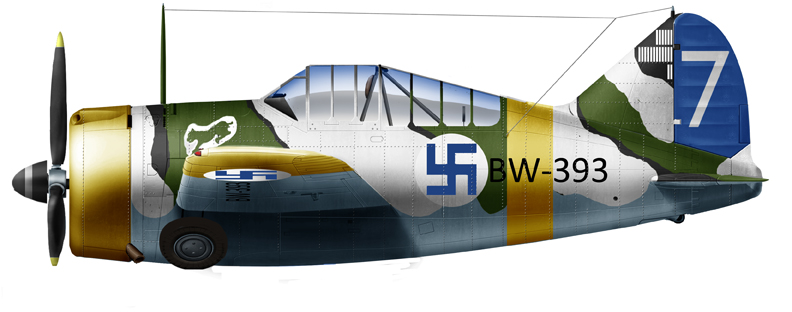
Brewster B-239 of LeLv 24 in 1943
The B-239E fighters arrived too late to take part in the Winter War however but they shone during the Continuation War: They performed well despite some issues, solved by the local mechanics, playing with inverted piston rings. The cold also addressed the overheating problem. Teaming up with the Fiat G.50, they achieved the amazing kill ratio of 33/1. Lentolaivue (“Squadron”) 24 until 1945 for example claimed 477 kills for 19 Buffalos losses, and some were transferred to Hävittäjä Lentolaivue 26, claiming 459 kills for 15 losses. Among others, the four-plane “parvi” formation was soon successful one pair used as bait, the other diving on interceptors. Hans Wind was Finnish’s top scorer 39 kills, with LeLv 24. The squadron 42½ kills by combining all its pilots make one of the highest-scoring fighter in history. Top Finnish ace Ilmari Juutilainen, made 34 kills our of his 94½ on the Brewster B-239s codenamed BW-364. Due to the production stoppe din the US and difficult supplies, the Finns tried to replicate locally the Buffalo using plywood, called the” Humu”, a single prototype. By late 1943, these B-239s started to suffer fro worn-out components, and facing a getter opposition, but they fought on until mid-1944, scoring a last kill on 17 June 1944. They had been all replaced by Bf 109Gs. However a few Brewsters also fought during the “Lapland War”, those from HLeLV 26 on 3 October 1944. The last of them was retired on 14 September 1948.
The Belgian Buffalos
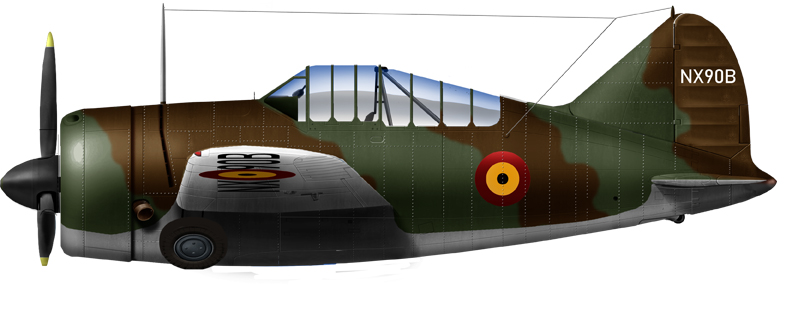
Never delivered Belgian Buffalo at Darthmouth, Halifax, Canada, in June 1940.
Although this is largely anecdotal, Belgium was the second country to order the Buffalo after Finland. 40 Brewster B-339 were ordered, essentially de-navalized F2A-2 equipped with the Wright R-1820-G-105 engine approved for export. It had a 1,000 hp (745.7 kW) output on takeoff which was 200 hp (149 kW) less than Navy F2A-2 engine. It also had a slightly longer tail. However, only one reached France on 10 May 1940. It never joined an active unit and was later captured intact by the Germans, but apparently studied but never used and it rediscovered near Darmstadt in 1945.
Six more Belgian Brewsters were offloaded at the French Caribbean island of Martinique and stayed there until they rusted away until the end of war, while the remainder of the order went directly to the RAF.
The British Buffalos
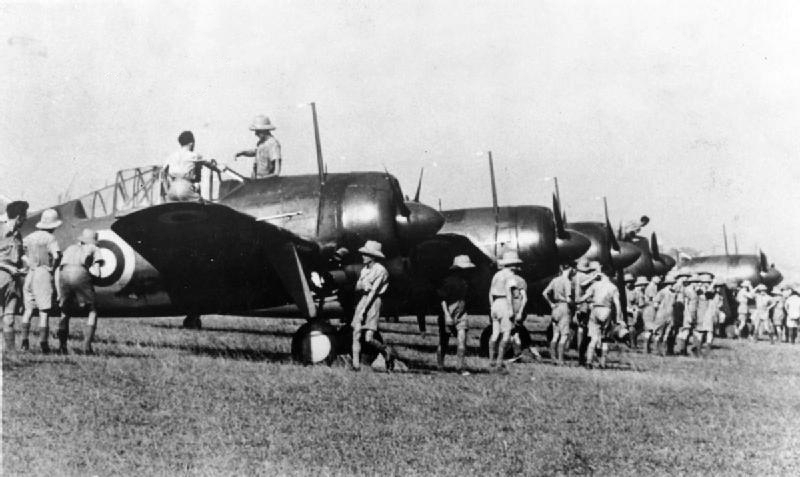
Brewster Buffalos MkI of the RAAF in Singapore, October 1941
In January 1940, the British government created British Purchasing Commission to acquire U.S. aircraft as soon as possible, making up for the shortcomings of domestic production. The Brewster as examined, and there was already a park of 32 B-339 Belgian ordered aircraft, that were never shipped due to the fall of France in May. They were subsequently passed on to the UK. The RAF personnel however quickly criticized its inadequate armament, no armor nor sealing tanks, and general poor performance, plus engine overheating and maintenance problems. The pilots also complained bout poor cockpit ergonomics. However they still appreciated its handling, room and visibility inside. Its top speed was just 323 mph (520 km/h) at 21,000 ft (6,400 m) and altitude too low, so it was considered unfit for western Europe. It was decided to pass it on to the British and Commonwealth air forces, always short of planes, and to this, the government ordered a complement of 170 aircraft, called B-339E. They were sent directly to the RAF, Royal Australian Air Force (RAAF) and Royal New Zealand Air Force (RNZAF). Their fighter squadrons were based in Singapore, Malaya and Burma, and were ready by December 1941.
In addition to the Buffalo I own issues, pilots which had to flew it completely lacked training on their machines, which arrived by crates. In total 20 were lost in training accidents but in 1941 circa 150 Buffalo Mark I were serviceable, tasked to defend Burma, Malaya and Singapore, which was quite a stretch. They equipped two RAF, two RAAF and a single RNZAF fighter squadrons and until January 1942 performed very poorly as predicted. Aviation historian Dan Ford stated “The performance… was pathetic.” The lack of spare parts and support, plus targeted airfields, the absence of a clear and coherent command structure, lack of coordination between the RAF and RAAF squadrons, were all contributing to an unmitigated disaster. On 8 December 1941 in Malaysia, the B-339E obtained some kills against the Nakajima Ki-27 “Nate”, but the arrival of the Nakajima Ki-43 “Oscar” shifted the balanced completely. Duels became one-sided while others were lost on the ground. Their overheating engine under these climates traduced by oil spray over the windscreen, causing many pilots to get back to the airfield shortly after taking-off. 60 Brewster Mk I were shot down and 40 destroyed on the ground, but 20 survived the onslaught and reached India or the Dutch East Indies, fighting on until the fall of Java.
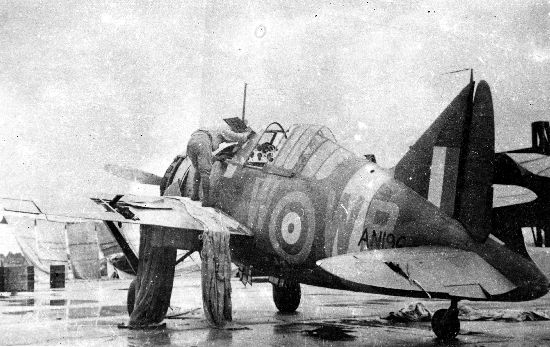
A Buffalo Mark I being refuelled, from the No. 243 Squadron RAF. It was flewn by flying Officer Maurice Holder, first in th air on a Buffalo during the Malayan Campaign on 8 December 1941.
The last Buffalo in Singapore was in action on 10 February, five days before the fall. RAAF pilots nevertheless claimed at least 20 Japanese planes, and overall they claimed around 80 planes, a kill ratio of 1.3 to 1, bombers making the bulk of it. It should be noted that the Fleet Air Arm also used the Buffalo in the Mediterranean in the Battle of Crete in early 1941.
The No. 67 Squadron RAF (Burma) had 30 Buffalos, and later P-40 fighters (Flying Tigers). Some pilots of the latter unit were initially impressed with the Buffalo, but Chennault organized a mock dogfight between them and there was no contest. They fought over Rangoon and Mingaladon and attacked Japanese airfields. Pilots started to adapt their tactics and by February 1942, Japanese air superiority was achieved. Six Buffalos fled to Calcutta and pilots were re-equip with Hurricanes. The RAF only ace was Maurice Holder, with 5 victories.
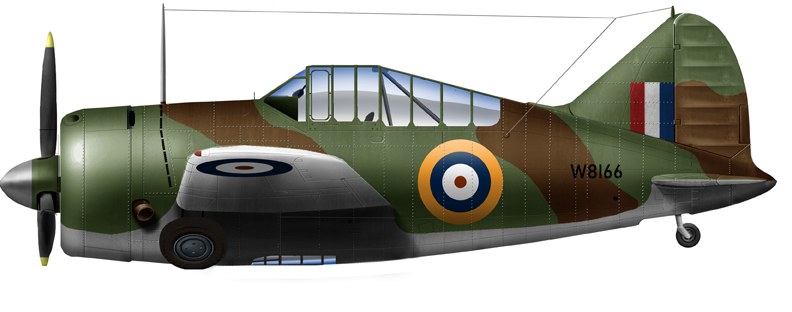
Buffalo Mark I (B-339E) of the RAF 4th PRY in Mingaladon, December 1941
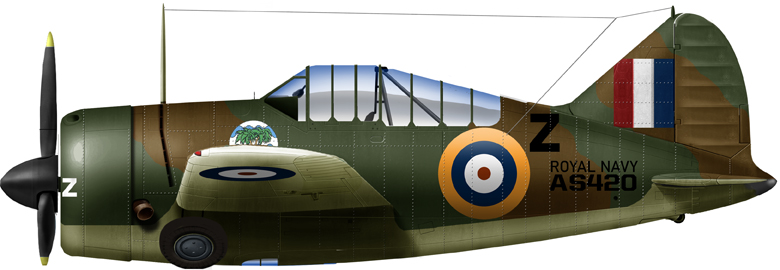
Buffalo Mark I of the 805 squadron Fleet air Arm at Maleme, Crete, May 1941
The Dutch KNIL Buffalos
The Militaire Luchtvaart van het Koninklijk Nederlands-Indisch Leger (ML-KNIL) had the authorirty and blessing from the government to order 144 Brewster B-339C and 339D models. The first had rebuilt Wright G-105 engines and the second, a new 1,200 hp (895 kW) Wright R-1820-40 engine. 71 were shipped to the Dutch East Indies, and a few served briefly at Singapore, withdrawn later.
Lighter than the British Buffalo I (B-339E) and other commonwealth models, they performed better, pilots wilfully engaging with confidence the Ki-43 “Oscar”. But still, pilots wanted them lighter and they halved the fuel and ammo load, allowing them to match Oscars in turns. By February 1942 they received new gunsight and tracer ammunition. But their armament stayed light, even against the lightly-protected Zero and Oscar. Some pilots used them as dive bombers against Japanese troopships. They fought in February-March with a 1-3 Japanese superiority. To spare fuel and maximize defence, a British radar station was shipped there, but only became operational at the end of February. The Dutch Buffalos obtained successes, like over Semplak on 19 February 1942, when the eight Brewster fighters intercepted a wave of 35 Japanese bombers escorted by 20 Zeros and managed to claim 11 for the loss of 4. Only four Buffalos had survived on 7 March. No ace, the best pilots had three kills each. 30 Buffalos had been shot down, plus 15 on the ground and others in accidents, for 55 kills, so close to a 1.1 ratio.
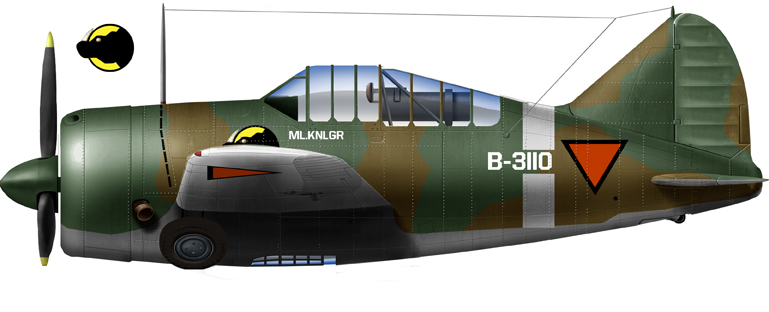
B-339C of the Vligtuig Groep V, ML-KNIL, Java Autumn 1941. B-396 pilot Lt. Dreibel became an ace.
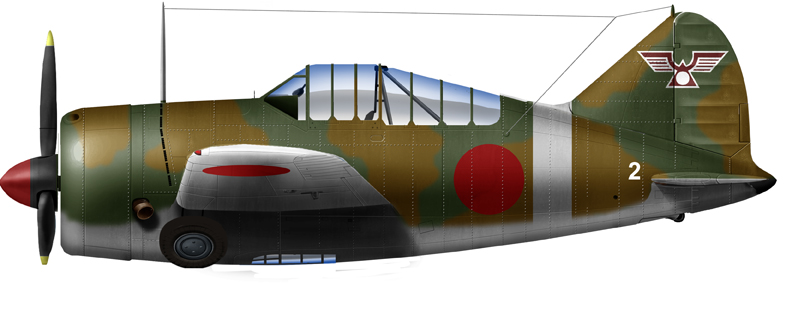
One of the captured Brewsters B-339C in Java, evaluated in mid-1942 by the Japanese.
The RAAF/RNZN Buffalos
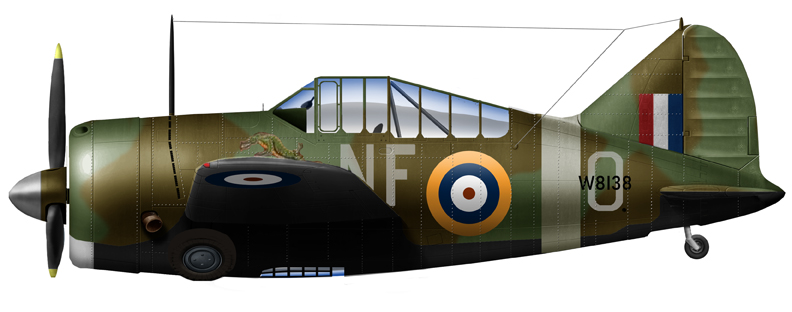
Buffalo Mark I (Brewster B-339E) of the RNZAF in Singapore, 1941
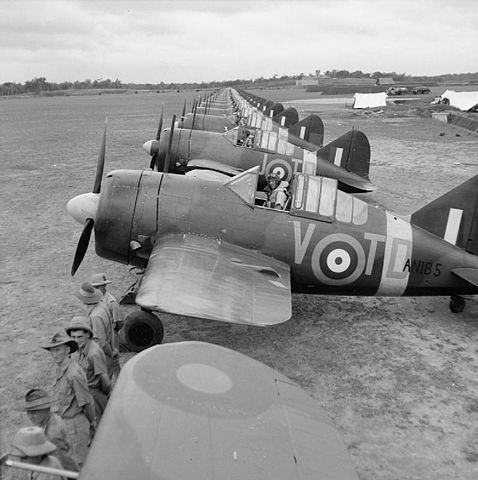
Buffalo Mark I of the RAAF (B-339E) of No. 453 Squadron RAAF at RAF Sembawang, November 1941.
The first ones served n the defence of Malaya, Burma and Singapore (see above). The fall of Singapore had surviving planes retreating to the Netherlands East Indies in March 1942, and then were lost there. Meanwhile as the fall of Java was imminent, 17 further B339-23 which were to be delivered to the ML-KNIL were diverted to Australia and transferred to the U.S. Fifth Air Force. They were lent to the RAAF there, and used mainly for point air defence but also photo-reconnaissance and gunnery training, with 1st PRU, 24 Sqn, 25 Sqn, 85 Sqn and the RAAF Gunnery Training School. 10 of these until November 1943, defended Perth in Western Australia with the 25 and 85 Sqns RAAF Pearce & Guildford. In 1944 they were transferred back to the USAAF and likely used for static training, target towing planes, or scrapped. Geoff Fisken (RNZAF) was the top Buffalo ace with six victories, Doug Vanderfield (RAAF) five, as well as Alf Clare.
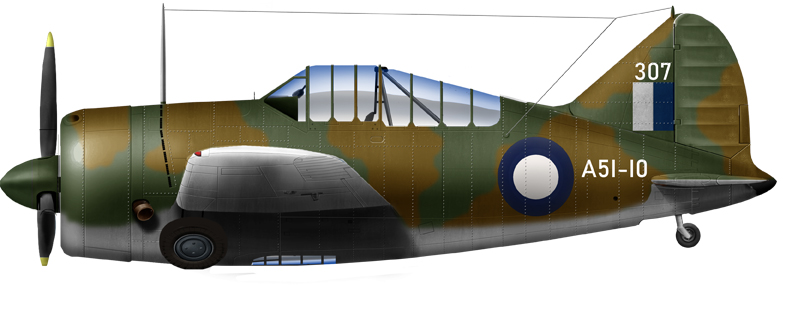
B-339-23 of the 25th Squadron RAAF in Western Australia, September 1942
Videos
Part I of Blacktail 17 about the Buffalo Part II

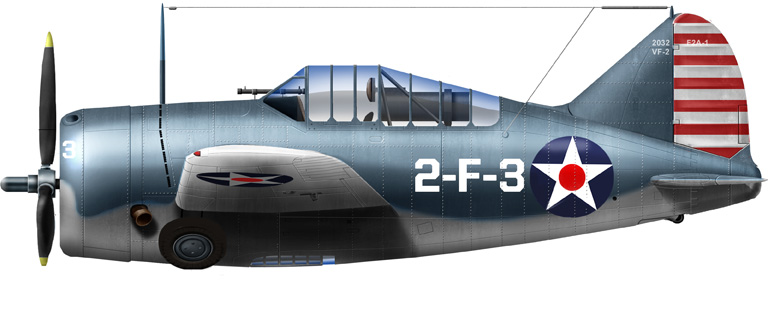

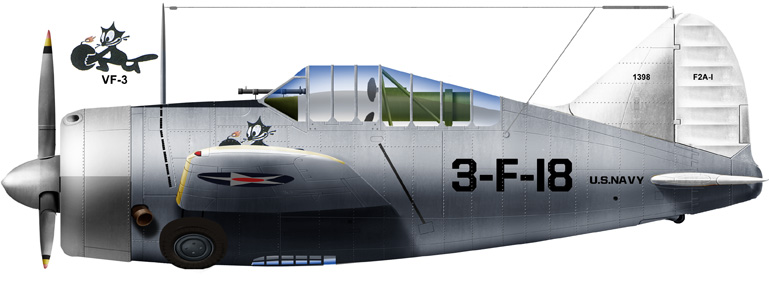
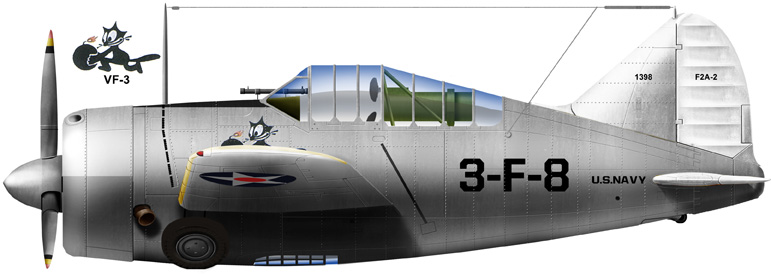
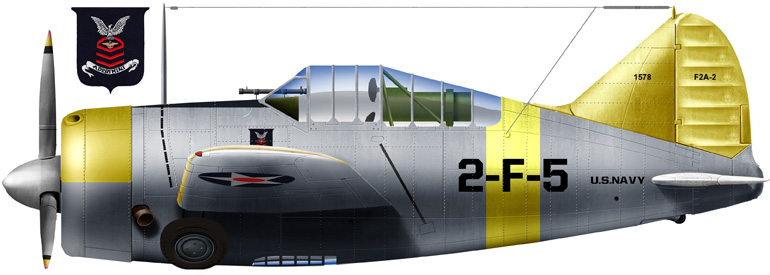
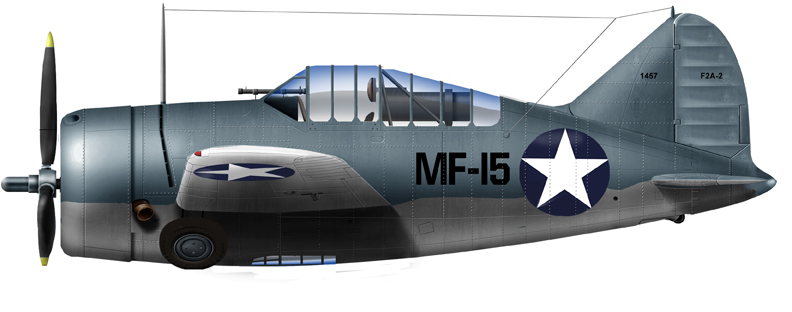
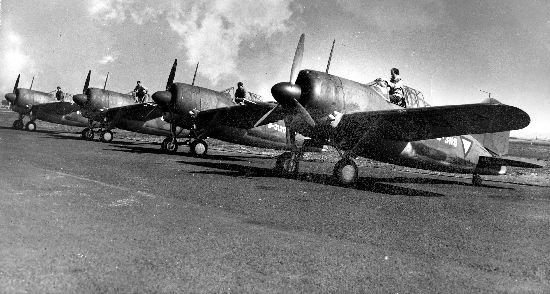
 Latest Facebook Entry -
Latest Facebook Entry -  X(Tweeter) Naval Encyclopedia's deck archive
X(Tweeter) Naval Encyclopedia's deck archive Instagram (@navalencyc)
Instagram (@navalencyc)





 French Navy
French Navy Royal Navy
Royal Navy Russian Navy
Russian Navy Armada Espanola
Armada Espanola Austrian Navy
Austrian Navy K.u.K. Kriegsmarine
K.u.K. Kriegsmarine Dansk Marine
Dansk Marine Nautiko Hellenon
Nautiko Hellenon Koninklije Marine 1870
Koninklije Marine 1870 Marinha do Brasil
Marinha do Brasil Osmanlı Donanması
Osmanlı Donanması Marina Do Peru
Marina Do Peru Marinha do Portugal
Marinha do Portugal Regia Marina 1870
Regia Marina 1870 Nihhon Kaigun 1870
Nihhon Kaigun 1870 Preußische Marine 1870
Preußische Marine 1870 Russkiy Flot 1870
Russkiy Flot 1870 Svenska marinen
Svenska marinen Søværnet
Søværnet Union Navy
Union Navy Confederate Navy
Confederate Navy Armada de Argentina
Armada de Argentina Imperial Chinese Navy
Imperial Chinese Navy Marinha do Portugal
Marinha do Portugal Mexico
Mexico Kaiserliche Marine
Kaiserliche Marine 1898 US Navy
1898 US Navy Sovietskiy Flot
Sovietskiy Flot Royal Canadian Navy
Royal Canadian Navy Royal Australian Navy
Royal Australian Navy RNZN Fleet
RNZN Fleet Chinese Navy 1937
Chinese Navy 1937 Kriegsmarine
Kriegsmarine Chilean Navy
Chilean Navy Danish Navy
Danish Navy Finnish Navy
Finnish Navy Hellenic Navy
Hellenic Navy Polish Navy
Polish Navy Romanian Navy
Romanian Navy Turkish Navy
Turkish Navy Royal Yugoslav Navy
Royal Yugoslav Navy Royal Thai Navy
Royal Thai Navy Minor Navies
Minor Navies Albania
Albania Austria
Austria Belgium
Belgium Columbia
Columbia Costa Rica
Costa Rica Cuba
Cuba Czechoslovakia
Czechoslovakia Dominican Republic
Dominican Republic Haiti
Haiti Hungary
Hungary Honduras
Honduras Estonia
Estonia Iceland
Iceland Eire
Eire Equador
Equador Iran
Iran Iraq
Iraq Latvia
Latvia Liberia
Liberia Lithuania
Lithuania Mandchukuo
Mandchukuo Morocco
Morocco Nicaragua
Nicaragua Persia
Persia San Salvador
San Salvador Sarawak
Sarawak Uruguay
Uruguay Venezuela
Venezuela Zanzibar
Zanzibar Warsaw Pact Navies
Warsaw Pact Navies Bulgaria
Bulgaria Hungary
Hungary

 Bundesmarine
Bundesmarine Dutch Navy
Dutch Navy Hellenic Navy
Hellenic Navy Marina Militare
Marina Militare Yugoslav Navy
Yugoslav Navy Chinese Navy
Chinese Navy Indian Navy
Indian Navy Indonesian Navy
Indonesian Navy JMSDF
JMSDF North Korean Navy
North Korean Navy Pakistani Navy
Pakistani Navy Philippines Navy
Philippines Navy ROKN
ROKN Rep. of Singapore Navy
Rep. of Singapore Navy Taiwanese Navy
Taiwanese Navy IDF Navy
IDF Navy Saudi Navy
Saudi Navy Royal New Zealand Navy
Royal New Zealand Navy Egyptian Navy
Egyptian Navy South African Navy
South African Navy






























 Ukrainian Navy
Ukrainian Navy dbodesign
dbodesign